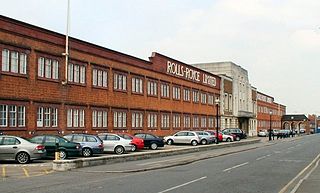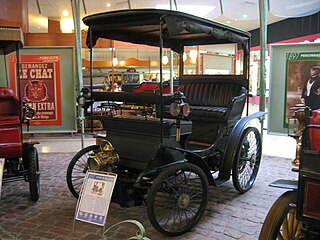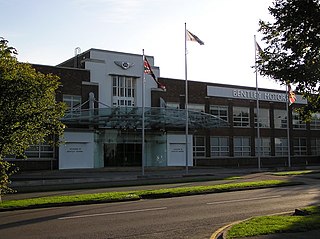Bentley Motors Limited is a British designer, manufacturer and marketer of luxury cars and SUVs. Headquartered in Crewe, England, the company was founded by W. O. Bentley (1888–1971) in 1919 in Cricklewood, North London, and became widely known for winning the 24 Hours of Le Mans in 1924, 1927, 1928, 1929 and 1930. Bentley has been a subsidiary of the Volkswagen Group since 1998 and consolidated under VW's premium brand arm Audi since 2022.

A V12 engine is a twelve-cylinder piston engine where two banks of six cylinders are arranged in a V configuration around a common crankshaft. V12 engines are more common than V10 engines. However, they are less common than V8 engines.

Charles Stewart Rolls was a British motoring and aviation pioneer. With Henry Royce, he co-founded the Rolls-Royce car manufacturing firm. He was the first Briton to be killed in an aeronautical accident with a powered aircraft, when the tail of his Wright Flyer broke off during a flying display in Bournemouth. He was aged 32.

Peugeot is a French automobile brand owned by Stellantis.

The automotive industry in the United Kingdom is now best known for premium and sports car marques including: Aston Martin, McLaren, Bentley, Rolls-Royce, Jaguar, Range Rover, Mini and Lotus. Specialised sports car companies include: Ariel, BAC, Morgan, Caterham, AC Cars, Gordan Murray, TVR, Noble, Radical, Ginetta, Ultima Sports, Westfield, Lister, Arash and David Brown. Volume car manufacturers with a major presence in the UK include: Nissan, Toyota, Mini and Vauxhall. Commercial vehicle manufacturers active in the UK include Alexander Dennis, Dennis Eagle, IBC Vehicles, Leyland Trucks, TEVVA and the London Electric Vehicle Company.
Armstrong Siddeley was a British engineering group that operated during the first half of the 20th century. It was formed in 1919 and is best known for the production of luxury vehicles and aircraft engines.

The Rolls-Royce Silver Seraph is a large luxury automobile produced by Rolls-Royce Motors from 1998 to 2002. First unveiled on 3 March 1998 at the Geneva Motor Show, it replaced the Silver Spirit, which ended production in 1997. Silver Seraph production was discontinued when the licence to use the Rolls-Royce marque was sold to BMW, which began manufacture of an unrelated line of vehicles under a new corporation, Rolls-Royce Motor Cars.

The Rolls-Royce Silver Dawn is a full-size luxury car that was produced by Rolls-Royce at their Crewe works between 1949 and 1955. It was the first Rolls-Royce car to be offered with a factory built body which it shared, along with its chassis, with the Bentley Mark VI until 1952 and then the Bentley R Type until production finished in 1955. The car was first introduced as an export only model. The left hand drive manual transmission models had a column gear change, while right hand drives had a floor change by the door. In the British home market the Silver Dawn only became available from October 1953, with the introduction of the model corresponding to the Bentley R Type.

The Bentley S1 was a luxury car produced by Bentley Motors Limited from 1955 until 1959. The S1 was derived from Rolls-Royce's complete redesign of its standard production car after World War II, the Silver Cloud. Each was its maker's last standard production car with an independent chassis. The S-series Bentley was given the Rolls-Royce - Bentley L Series V8 engine in late 1959 and named the S2. Twin headlamps and a facelift to the front arrived in late 1962, resulting in the S3. In late 1965, the S3 was replaced by the new unitary construction Rolls-Royce Silver Shadow-derived T series.

The Rolls-Royce Corniche is a two-door, front-engine, rear wheel drive luxury car produced by Rolls-Royce Motors as a hardtop coupé and as a convertible.

The Rolls-Royce Phantom II was the third and last of Rolls-Royce's 40/50 hp models, replacing the New Phantom in 1929. It used an improved version of the New Phantom engine in an all-new chassis. A "Continental" version, with a short wheelbase and stiffer springs, was offered.
Rolls-Royce Motor Cars Limited is a British luxury automobile maker that has operated as a wholly owned subsidiary of BMW AG since 2003 – as the exclusive manufacturer of Rolls-Royce-branded motor cars. The company's administrative and production headquarters are located on the 42-acre (17 ha) Goodwood Estate in Goodwood, West Sussex, England, United Kingdom.

Rolls-Royce Limited was a British luxury car and later an aero-engine manufacturing business established in 1904 in Manchester by the partnership of Charles Rolls and Henry Royce. Building on Royce's good reputation established with his cranes, they quickly developed a reputation for superior engineering by manufacturing the "best car in the world". The business was incorporated as "Rolls-Royce Limited" in 1906, and a new factory in Derby was opened in 1908. The First World War brought the company into manufacturing aero-engines. Joint development of jet engines began in 1940, and they entered production in 1944. Rolls-Royce has since built an enduring reputation for the development and manufacturing of engines for military and commercial aircraft.

A V8 engine is an eight-cylinder piston engine in which two banks of four cylinders share a common crankshaft and are arranged in a V configuration.

Voitures automobiles Decauville was a French automobile maker, a subsidiary of Société Decauville, a company already famous for producing locomotives, located at Petit-Bourg, near Corbeil.

The Peugeot Type 105 was a large vehicle unveiled by Peugeot in 1908. The available body styles included double phaéton, landaulet, limousine, and sport. However, most were built as closed-top limousines. Total production lasted less than two years and saw the production of 23 units. Low production numbers and many available styles ensured almost complete uniqueness of each Type 105.

The Peugeot Type 16 was a mid-size family car produced by French automaker Peugeot from 1897 to 1900. The flat-twin engine was of the same series produced in the contemporaneous Peugeot Type 15, though the engine in the heavier Type 16 was enlarged to 2.4 L. During the production run, the Type 16 was joined in its class by the smaller Peugeot Type 17, the similar Type 19, and the larger Type 32. A total of 87 Type 16s were built.

Bentley Crewe, also named the Pyms Lane site after the street it is located on; is the headquarters and design and manufacturing centre of Bentley Motors Limited on the outskirts of Crewe, Cheshire, England. The site covers an area of 521,111 m2 (5,609,190 sq ft), of which 166,930 m2 (1,796,800 sq ft) is indoors.
The Peugeot Type 14 is an early motor car produced between 1897 and 1898 by the French auto-maker Peugeot at their Audincourt plant. First presented in public at the end of 1896 the Type 14 was the first new car introduction after Armand Peugeot’s new company “Automobiles Peugeot” had been registered, following formalisation of Armand's split from the then principal Peugeot business.

The Peugeot Type 9 was a particular model of early automobile manufactured by the French company Automobiles Peugeot between 1894 and 1897, during which time 87 examples were built. It was equipped with a 1.2 liter v-twin engine made in conjunction with Daimler, one of 257 such vehicles produced. The Type 9 was advertised as the brand's first closed-top family car. Like most European vehicles from this time period, it had very small dimensions and mirrored the design style of horse carriages. A 1894 Type 9 chassis was the first ever vehicle in the world to be equipped with pneumatic tires(by Michelin). It was called L'Éclair and participated in the 1895 Paris-Bordeaux-Paris race.
















